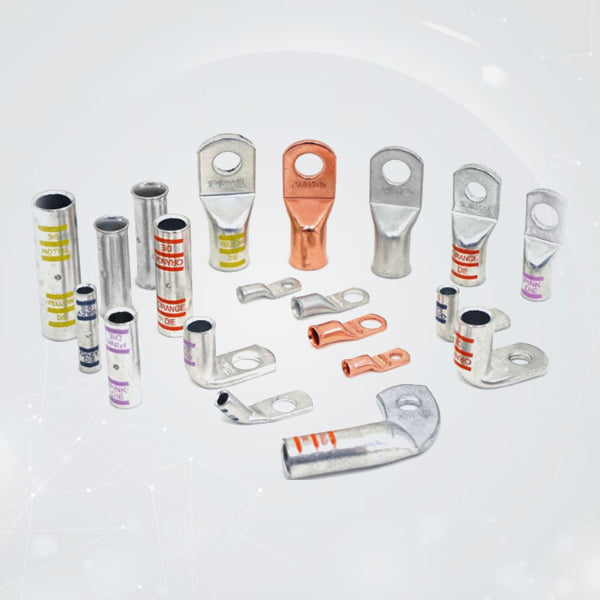
Copper vs Aluminum 2 Gauge Lugs: Which One Performs Better?
If you're setting up a power system, maybe an RV, solar battery bank, marine application, or off-grid build, you've probably come across the choice between copper and aluminum lugs. On paper, they may look similar. Same shape, same size, both rated for 2 AWG cable lug. But once you start running current through them, the differences show up fast.
So, what’s the better option when you're working with 2 AWG wire lugs? Let's break it down.
What’s The Job Of A 2 AWG Lug?
Before we start comparing, here’s a quick refresher.
A 2 AWG cable lug connects heavy-duty wire, like 2 gauge copper, to a solid point: battery posts, inverter terminals, grounding blocks, etc. The lug is crimped onto the bare wire and bolted into place, allowing current to pass cleanly and securely from one part of your system to another.
Simple, right? But the material that lug is made from makes a big difference in performance, safety, and longevity.
Why Copper Lugs Are The Industry Standard
At Selterm, we manufacture and recommend copper lugs 2 AWG because they consistently outperform aluminum in the conditions most of our customers work in. Here's why:
1. Better Conductivity
Copper has substantially better electrical conductivity than aluminum, approximately 40% higher. That means less resistance, less heat, and more effective power transfer.
Especially in systems with high draw, like solar inverters or lithium banks, copper 2 gauge lugs help you get the most out of your wiring without the problem of voltage drop.
2. Less Heat Buildup
Heat is a killer in electrical systems. It damages insulation, reduces efficiency, and can even become a fire risk. Since copper lugs run cooler under the same load, they’re safer, especially in tight compartments like RV bays or marine engine rooms.
3. Stronger Mechanical Connection
Copper is not just a better conductor, it’s also physically tougher. It crimps tighter, holds better over time, and is less prone to cracking or stress fractures. If you're using 2 AWG wire lugs in high-vibration environments (like boats or off-road rigs), this matters.
4. More Corrosion Resistant When Tinned
Bare copper does oxidize over time, but when you use tinned copper lugs 2 awg, you get the conductivity of copper with a protective barrier that resists corrosion. That’s why Selterm offers both bare and tinned options depending on your install environment.
Where Aluminum Lugs Might Be Used (And Why You Should Be Cautious)
Let’s be fair, aluminum lugs aren’t always bad. They’re cheaper and lighter, which makes them attractive for large-scale utility or industrial applications where cost is a big factor.
But for DIYers, installers, or anyone working on mobile or residential power systems, there are some real drawbacks:
1. Higher Resistance = More Heat
Aluminum lugs can cause significant voltage drop, especially in 12V or 24V systems where every volt counts. And since they generate more heat, that adds risk, especially if the lug isn’t perfectly crimped.
2. More Maintenance
Aluminum is more reactive to air and moisture. Over time, oxidation creates a layer that actually inhibits conductivity. To prevent this, aluminum lugs need to be regularly cleaned or coated, not ideal for most installs.
3. Requires Antioxidant Compound
If you do choose aluminum, you’ll need to use a special anti-oxidant grease between the wire and lug to prevent degradation. It’s messy, and if you skip that step, the connection won’t last.
Real-World Scenarios: Copper Outperforms
Let’s look at some common use cases where copper lugs 2 AWG show their value:
- RV battery banks: Copper lugs reduce voltage loss across long cable runs, which means more usable power for your appliances and less strain on your inverter.
- Solar installations: In solar DC systems, every watt matters. Using high-conductivity 2 AWG wire lugs keeps resistance low and efficiency high.
- Marine systems: Saltwater, moisture, and movement all work against electrical components. Tinned copper lugs hold up better and last longer than aluminum.
- Car audio builds: Aluminum lugs can struggle under heavy bass loads. Copper lugs handle the high amps without heating up or distorting the sound.
What You Get With Selterm Copper Lugs
Selterm’s copper lugs 2 awg are built for performance in real-world conditions. Here’s what sets them apart:
- Made from 99.9% pure electrolytic copper
- UL & CUL listed for safety.
- Precision-machined for consistent crimping
- Available in bare and tinned finishes
- Compatible with most professional-grade crimping tools
- Chamfered for easy wire insertion
We don’t cut corners, because we know our customers don’t either. Whether you’re wiring your off-grid cabin or upgrading your boat’s electrical system, our lugs are designed to hold strong and conduct clean for years.
Final Verdict: Copper Wins For Performance And Reliability
If you’re debating between copper and aluminum for your 2 gauge lugs, here’s the bottom line:
- For conductivity, copper wins
- For heat resistance, copper wins.
- For corrosion durability, copper wins (especially when tinned)
- For long-term reliability, copper wins hands down.
Sure, aluminum lugs are cheaper. But in power systems where every connection matters, they’re often a shortcut that costs you more in the long run.
So if you’re wiring up with a 2 AWG cable lug, don’t take chances. Go with copper. It’s what we use. It’s what we trust.





